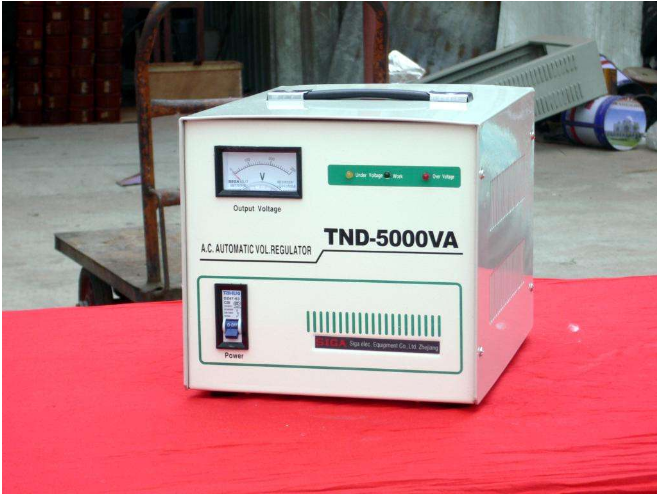The function of the household voltage stabilizer is to stabilize the power supply voltage required by large fluctuations and unsuitable electrical equipment within its set value range, so that various circuits or electrical equipment can work normally under the rated working voltage. Series AC automatic voltage regulators are composed of contact autotransformers, servo motors, automatic control circuits, etc. When the grid voltage is unstable or the load changes, the automatic sampling voltage regulator control circuit sends out a signal to drive the servo motor to adjust the autocoupling The position of the carbon brush of the voltage regulator enables the output voltage of the voltage regulator to be adjusted to the rated value and reach a stable state. This series of regulators has many advantages such as variety, complete specifications and beautiful appearance. It has the characteristics of undistorted waveform, high efficiency, reliable performance, and long-term operation. The voltage regulator is equipped with protection functions such as short delay and overvoltage, and long delay and undervoltage protection functions can be added according to user needs. This voltage regulator can be widely used in any place where electricity is used. It is an ideal stabilized power supply (voltage regulator) to ensure the normal operation of your electrical equipment. 1. Because the LED is a low-voltage DC product, and the city power is AC 220V, its work requires LED driving power. The LED drive power supply is a power converter that converts the power supply into a specific voltage and current to drive the LED to emit light. Under normal circumstances: the input of the LED drive power includes high voltage power frequency AC (ie city power), low voltage DC, high voltage DC, low voltage and high voltage. Frequency AC (such as the output of an electronic transformer), etc. 2. LED driving principle: The relationship between the forward voltage drop (VF) and the forward current (IF). When the forward voltage exceeds a certain threshold (about 2V), which is commonly referred to as the on-voltage, it can be approximated that IF is proportional to VF. The highest IF of the current ultra-bright LED can reach 1A, and the VF is usually 2 to 4V. Note: The temperature of the LED is inversely proportional to the luminous flux (φV). The luminous flux at 85°C is half of that at 25°C, and the light output at 40°C is 1.8 times that at 25°C. The temperature change also has a certain influence on the wavelength of the LED. Therefore, good heat dissipation is the guarantee for the LED to maintain a constant brightness. HuiZhou Superpower Technology Co.,Ltd. , https://www.spchargers.com
Since the light characteristics of LEDs are usually described as a function of current, rather than a function of voltage, a constant current source drive can better control the brightness. In addition, the forward voltage drop of the LED has a relatively large range (up to 1V or more), and a small change in VF will cause a large change in IF, which will cause a large change in brightness. Therefore, using a constant voltage source to drive cannot guarantee the consistency of LED brightness, and affects the reliability, life and light attenuation of the LED. Therefore, ultra-bright LEDs are usually driven by a constant current source.
How to change the principle of household AC voltage regulator to AC 120V LED drive to 220V use
Home AC Voltage Regulator